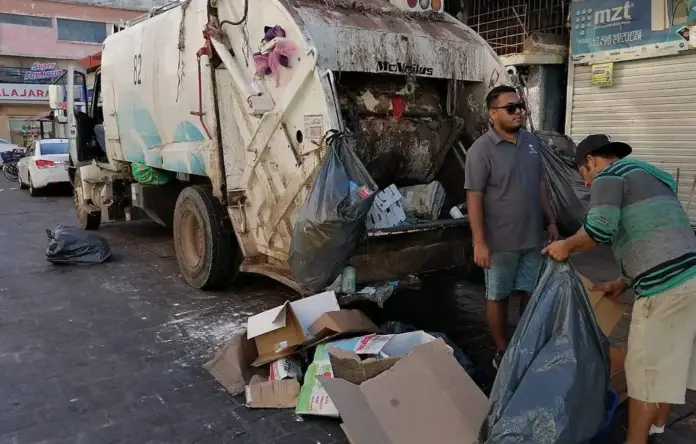In the last 20 years, Mazatlán’s urban area has grown 2.39 times, and in the last 10 years, garbage generation has increased from 15 to 40 percent. However, one of the most important tourist destinations in the northwest of the country has an obsolete fleet of garbage collection trucks.
According to the Movable Property Inventory, the Mazatlán City Council has 64 garbage collection trucks, most of which were acquired between 2017 and 2020, although there are also units from 2005 and 2010.
In addition, 25 new garbage collection trucks were acquired between 2022 and 2023, but 50 percent of this fleet is obsolete or out of service, as the Urban Sanitation Department currently provides garbage collection services with 46 units.
The collectors are working at full speed, as they provide service to more than 300 neighborhoods every day in a city that generates 700 tons of garbage per day.
They’re “on the bench”
The Urban Sanitation Department has a total of 66 collection routes, of which 46 are morning and 20 are nighttime.
The vehicle fleet consists of a total of 46 units, but two are “on the bench” (repair shop) every day for repair and maintenance work.
Despite this, the Public Services Directorate assures that it has 100 percent coverage for solid waste collection, not only in the city but throughout the entire municipality, said Karla Camacho Guzmán, head of the department.
“We’re ‘banking’ two trucks per day, two routes, to provide maintenance and service. We want to give the best possible image for the upcoming Easter period. Two trucks remain in the workshop, and when the first trucks that finished their morning route arrive, these two routes will be used to complete the morning collection,” he explained.
Each route covers four to five neighborhoods, and each garbage truck goes two to three times a day to unload waste at the dump.
“Mazatlán has grown so much that it would be very beneficial for our existing routes to ease pressure a bit so we can have more morning routes. Now that the grasslands are growing more, in the Santa Teresa area, these routes have been increasing in volume,” he acknowledged.
There is currently an open bidding process to acquire five new units with a capacity of eight to nine tons, which would allow for a small readjustment of the routes and better scheduling and logistics to supply the public.
“It would be good to have two more surplus routes, or even to leave them as backups. With so many events in Mazatlán, we need backup routes where garbage is collected on the boardwalk twice a day during vacation periods; they have to make up to five trips,” he said.
Much of the garbage collection truck fleet has reached the end of its useful life; they are in poor condition or completely broken, and repairing them is more expensive than purchasing a new unit. Some are occasionally used as “wild cards” or spare parts are used when a replacement is missing.
“Some are very old models and are badly damaged. Repairing them is actually more expensive than purchasing a new garbage collection truck. They have served as a wild card, replacing the one left in the workshop. Some parts are useless while waiting for the originals to arrive. We have profited from them, and there are others that are ready to be retired,” Camacho Guzmán noted.
The municipal official reiterated that even with this number of units, the service is still running smoothly, and where they have had problems is with residents who take out their waste on unspecified days and times.
Santa Teresa, Pradera Dorada, El Conchi, Santa Fe, and Prados del Sol are some neighborhoods where this problem intermittently occurs, causing garbage to accumulate on the streets and increasing the risks of pollution and health, or clogging storm drains and grates.
Undated
The proper production, planning, and management of urban solid waste, with all that this entails (collection and proper disposal, as well as the implementation of recycling and education programs), is one of the main environmental challenges facing the municipality.
In the case of the municipality, the increase in the amount of solid waste generated is a problem derived from demographic and economic growth, a common phenomenon in many other cities. Today, the waste ends up in open-air dumps.
This has generated environmental problems such as the contamination of groundwater and nearby water bodies, as well as the emission of unpleasant odors. Due to the failure to comply with all the requirements of NOM-083SEMARNAT-2003, actions have been implemented to close and remediate the waste.
Municipal authorities are currently in the process of determining the location of a new sanitary landfill that complies with applicable regulations. Although it was announced on January 9 that the State Government would fund its construction by allocating 100 million pesos, to date there is no bidding process, nor is the location known.
“Work continues on the sanitary landfill. As you well know, there is a budget from the governor that he requested from the State Congress, and the Secretary of Public Works, Raúl Montero, and the Municipality of Mazatlán are working in coordination to ensure its implementation soon,” Mayor Estrella Palacios Domínguez stated last week.
Garbage collection trucks registered in the Real Estate inventory by year of acquisition:
2005: 4
2010: 4
2012: 7
2016: 5
2017: 10
2018: 11
2019: 7
2020: 10
2021: 6
2022: 10
2023: 15
Total: 89
In use: 46

Source: oem




